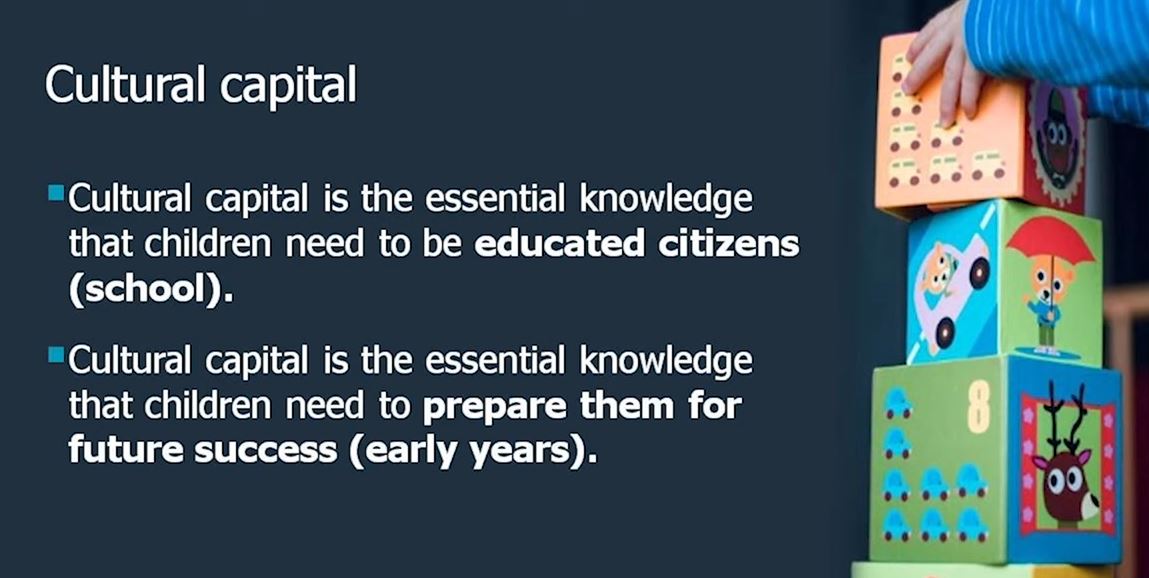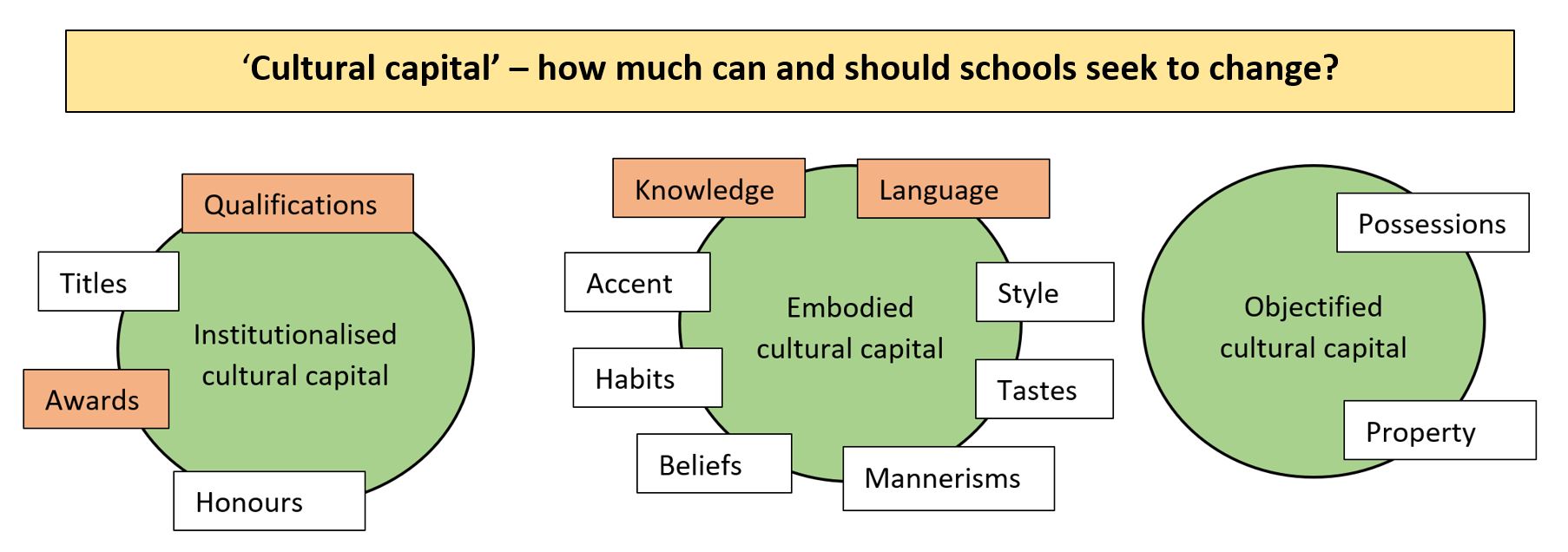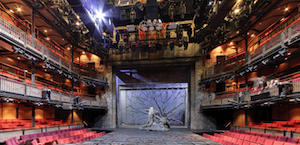Cultural Capital
What exactly is cultural capital, and how can schools promote its development?
Handley, C (2023, January 26). Cultural Capital. Retrieved from https://www.structural-learning.com/post/cultural-capital
What exactly is cultural capital, and how can schools promote its development?
Handley, C (2023, January 26). Cultural Capital. Retrieved from https://www.structural-learning.com/post/cultural-capital
The establishment of a new inspection framework from Ofsted in 2019, provided some major changes to how schools are inspected and how their quality is assured. They included an expectation that ‘cultural capital’ be inspected. Because therefore, schools now have to introduce this term to their whole school policy agenda.
Recently, I overheard a conversation with a Geography teacher and a student who was questioning why boys are out at sea, 24 hours, 7 days a week. Similarly, a conversation with a Maths teacher and a student about what a dress circle is and how this is related to a theatre and their practice question on prices of seats. In addition, a colleague also explained the confusion of a student when they explained their recent journey on the tube and on the underground, which followed with questions about why their teacher was apparently in a tube, underground and using it to get from place to place.
When referring to cultural capital, there is a wide range of theories. Is it referring to social capital or is it referring to economic capital and human capital? It is more specifically related to forms of capital with reference to economic capital and social mobility or is it, instead, more to do with class differences, class inequalities, someone's social network, forms of knowledge and accumulation of knowledge? Some may say that cultural capital refers to childhood education, arts activities leisure activities affecting cultural competence. However, others may say that the body of knowledge on cultural capital theory is too broad to summarise in one definition.
In this article, we aim to establish the range of definitions of cultural capital by considering the idea of capital and cultural capital from different perspectives. We then aim to consider what Ofsted say about cultural capital before considering what this means for senior leaders, middle leaders and classroom practitioners.
Bourdieu? Marx? Arnold? If you were a reader of English Literature or an Historian you might be familiar with the idea of ‘high and low’ culture and the idea of “the best which has been thought and said” (Arnold, 1875, p.10) which often seems to imply, whether right or wrong, that Shakespeare and Mozart and museum visits, not the integration of hip hop culture or vernacular cultures, should be generally written into the curriculum. The idea of cultural capital, however, if you are a sociologist, will be associated with Pierre Bourdieu (1977; 1984; 1986) or Marx (1967) and has more to do with power and the alienation of the working classes through certain types of ‘cultural capital’ than it has to do with maintaining what Matthew Arnold phrased “the best which that has been thought and said” (Arnold, 1875, p.10).
Neither the National Curriculum document (DfE, 2014) nor Ofsted (2019) offer elaboration on this definition in terms of criteria of Ofsted inspections, but simply state that they will be inspecting whether “leaders construct a curriculum [...] designed to give all learners [...] the knowledge and cultural capital they need to succeed in life” (Ofsted, 2019, p.9).
Pierre Bourdieu
The term cultural capital originates in the work of the French sociologist Pierre Bourdieu (Bourdieu, 1977; 1984; 1986). For Bourdieu (1977; 1984; 1986), cultural capital is specifically linked to social class and acquisition of cultural capital. Bourdieu (1986) says that it “can be acquired, to a varying extent, depending on the period, the society, and the social class” (p.245). It is, therefore, dependent on the upbringing of an individual and the influence their social class has on this.
Bourdieu (1977) also refers to the development of an individual’s habitus, which has links to both the external wealth of an individual as well as to embodied forms of cultural capital which might arise from grammar schooling, faith-based schooling or independent schooling.

Hirsch (1987), too, in his work on cultural literacy, proposed that there are certain kinds of knowledge that all individuals should have access to. In short, he says “To be culturally literate is to possess the basic information needed to thrive in the modern world” (Hirsch, 1987, p.12). This implies the requirement of a bedrock of essential knowledge to succeed in society. Reay (2017) points out that the conflation of Bourdieu’s concept (not necessarily to do with knowledge or, explicitly, the curriculum) and Hirsch’s idea of cultural literacy (which is to do with types of knowledge), is one of the most unhelpful aspects of Ofsted’s mis-definition of the term in their own policy documents (Reay, 2017).
Hirsch’s (1987) United States-based work on cultural literacy suggests that all individuals need to acquire essential, basic knowledge but he also says that “Children also need to understand elements of our literary and mythic heritage that are often alluded to without explanation” (Hirsch 1987, p.30). This means that when individuals hear, or interact with, names of multi-cultural mythic characters, characters in literature, art and music from across the world (Hirsch, 1987) they also need to be given the ‘social codes’ which enable them to read them (Hirsch, 1987). Lacking this, many will engage less well with and comprehend less about and from them. At worst further learning then becomes “increasingly toilsome, unproductive and humiliating” (Hirsch, 1987, p.28) particular if the social codes offered to them open out worlds which contradict the home habitus in which they are embedded from birth. The likelihood is that they will, then, at this point, give up trying at all. Hirsch suggest that “the most straightforward antidote to deprivation is to make the essential information more readily available inside the schools.” (Hirsch, 1987, p.24).
Hirsch (1987), like Arnold, suggests that “literate culture has become the common currency for social and economic exchange in our democracy, and the only available ticket to full citizenship” (p.22) Equality of opportunity, Hirsch (1987) suggests, is available to all if they have this shared cultural literacy because “shared background knowledge [enables them] to communicate effectively with everyone else” (p.32).
Accessing the curriculum has to be the prime motivator in developing cultural capital because, if you cannot access, it how are you ever going to understand it, let alone be socially mobile within its structures?
In more recent terms
Many other academics also see a link between social privilege (Mohr and DiMaggio, 1995) and academic achievement in schools. DiMaggio (1982) was one of the recent academics to consider a possible relationship between cultural capital and educational achievement and Bennett et al. (2009) produced a comprehensive analysis of the work of Bourdieu and cultural capital. In their work, they suggest that “Those parents equipped with cultural capital are able to drill their children in the cultural forms that predispose them to perform well in the educational system” (Bennett et al., 2009, p.13).
For Ofsted, the definition of cultural capital is:
“the essential knowledge that pupils need to be educated citizens, introducing them to the best that has been thought and said and helping to engender an appreciation of human creativity and achievement” (DfE, 2014, p.5).
The extent to which classroom teachers, middle or senior leaders are familiar with this idea, in the form it has entered education, would depend on how many had either studied or become in other ways acquainted with the mixture of ideas in this definition, in either first degree, initial teacher or other training.
So, with this working definition of cultural capital from the Department for Education, what are some of the misconceptions surrounding cultural capital and what could this mean for practitioners in the classroom, middle and senior leaders?
This exemplifies two ideas. Firstly, Matthew Arnold’s (1875) idea surrounding “the best which has been thought and said” (p.10) and, secondly, the idea that cultural literacy (Hirsch, 1977), a form of knowledge, is needed to acquire it. This is very different from both Marx and Bourdieu’s socially (semi) deterministic view of cultural capital. It suggests, for instance, that just ‘knowing about’ the idea of cultural literacy (explicit curriculum) is not as important as also ‘learning from’ it (implicit curriculum).
For example, by experiencing so called ‘high culture’ at first hand we validate different cultures (home or family influence) both implicitly and explicitly. Through assemblies, by introducing books or new Information Technology resources, such as iPads, into all schools, we are also both implicitly and explicitly insisting that those from disadvantaged backgrounds should have equal access to all sources of culture, not just the more limited ones they may experience at home.

It would be reasonable to suggest that many teachers may associate the acquisition of ‘knowing’ with acquiring cultural capital, without deeply understanding how. For Marx and Bourdieu, the ability to know is already skewed, in schools, by the curriculum’s own content and by pupils’ prior experience (habitus). Therefore, as a result, they do not currently understand that more sophisticated targeting, throughout both implicit and explicit curriculum, would be needed to truly implement Ofsted’s idea of ‘cultural capital.’
There is a three-pronged approach here involving:
1. Senior Leaders - Higher-level plan
2. Middle Leaders - Knowing your curriculum and supporting department colleagues
3. Classroom practitioners - Supporting students
It is not sufficient or worthwhile for leadership in a school to refer to cultural capital with the hope that, by the next staff meeting, the cultural capital box is being 'ticked'.
Yes, cultural capital is present as part of the Ofsted inspection framework. However, ensuring that students in schools have access to opportunities to enhance and build their cultural capital is equally, if not more, important, to ensure that they have an awareness of the best that has been thought and said to enable them to access the dish, diverse and complex society they are living in.
It would be highly beneficial for senior leaders to have a high-level plan to outline and track the journey for developing cultural capital within their school. Would you know what opportunities, experiences and references to the best that has been thought and said, for example, a Year 8 student has? Or, a Year 10 student? This higher level plan, then, would be produced in collaboration with middle leaders. It also creates some accountability for middle leaders to ensure that their curriculum are accessible to all, by addressing matters of the best that has been thought and said, and also culturally enriching.
One point of note, though. It would, of course, be lovely to visit a theatre or a classical music concert or travel on the London Underground. However, cultural capital development does not, and should not, only be limited to visiting physical places in person.
Knowing the curriculum you teach is important, as well as the essential knowledge that students may need to be successful in your subject. What does this mean in reality? It means knowing that students are diverse as is their cultural knowledge. For some, this may be quite limited. So, go through your schemes of learning and question whether there are any ambiguous themes, ideas or words that some may struggle to access. Once these are ascertained, use the opportunity not to fleetingly refer to a broad concept that might be related, but rather, to meaningfully help students to understand what they are learning about.
Maybe think of it like this and, if helpful, encourage your colleagues to think like this, too. Cultural capital cannot be successfully developed through merely experiencing something. Similarly, cultural capital cannot be developed through vague reference to an aspect of ‘culture’, without situating it within a wider contextual framework. Consider experience (E), understanding (U) and context (C).

The reference to ‘experience’ within this model does not, necessarily, refer to an experience of engagement with material culture.
It is designed to extend and enrich staff understanding of their task in engaging each student in cultural capital and aims to allow staff to question what it means for students to be a well-rounded citizen in a pluralist society.
Here are some examples that may help contextualise the thinking.
For example: the theatre

(Credit Royal Shakespeare Company)
If, in Drama, you are considering the composition of a theatre, with its range of seating, the concepts of the stalls, dress circle and upper circle may be challenging or unknown to some who have not experienced the theatre.
This is how using the suggested model above may support an enhanced cultural capital development.
Experience - Using an online tour of a theatre, find different seating types, question what the views of the stage are like from different seats. If students have iPads, why not get them to do this themselves?
Understanding - Get into discussions about why different seats are in a theatre, why these are at different prices, why there are boxes?
Context - Within these discussions, refer to the historical background of who would usually sit in the boxes, refer to why some boxes have plaques on and what these mean, give examples of local as well as famous theatres.
For example: the coast

(Credit to Pixabay)
If, in Geography, you are considering features of the coast, there will be a range of vocabulary that some students may not have been aware of before. Such as groynes, buoy and pier.
This is how using the suggested model above may support an enhanced cultural capital development.
Experience - Using your teacher iPad, use the Flyover feature on Apple Maps to visit different coastal locations. Then, give students some suggested locations for them to compare on their iPads.
Understanding - Then, ask Students to screen shot and highlight notable features. They could use their iPads to direct their conversations to certain coastal features and the teacher could use these conversations to address key words for these features.
Context - Teachers may then want to summarise why buoy or groynes are used at the coast. They might want to explain why many coastal locations have a pier, including why some now have piers that are not used any more.
The establishment of a new inspection framework from Ofsted in 2019, provided some major changes to how schools are inspected and how their quality is assured. They included an expectation that ‘cultural capital’ be inspected. Because therefore, schools now have to introduce this term to their whole school policy agenda.
Recently, I overheard a conversation with a Geography teacher and a student who was questioning why boys are out at sea, 24 hours, 7 days a week. Similarly, a conversation with a Maths teacher and a student about what a dress circle is and how this is related to a theatre and their practice question on prices of seats. In addition, a colleague also explained the confusion of a student when they explained their recent journey on the tube and on the underground, which followed with questions about why their teacher was apparently in a tube, underground and using it to get from place to place.
When referring to cultural capital, there is a wide range of theories. Is it referring to social capital or is it referring to economic capital and human capital? It is more specifically related to forms of capital with reference to economic capital and social mobility or is it, instead, more to do with class differences, class inequalities, someone's social network, forms of knowledge and accumulation of knowledge? Some may say that cultural capital refers to childhood education, arts activities leisure activities affecting cultural competence. However, others may say that the body of knowledge on cultural capital theory is too broad to summarise in one definition.
In this article, we aim to establish the range of definitions of cultural capital by considering the idea of capital and cultural capital from different perspectives. We then aim to consider what Ofsted say about cultural capital before considering what this means for senior leaders, middle leaders and classroom practitioners.
Bourdieu? Marx? Arnold? If you were a reader of English Literature or an Historian you might be familiar with the idea of ‘high and low’ culture and the idea of “the best which has been thought and said” (Arnold, 1875, p.10) which often seems to imply, whether right or wrong, that Shakespeare and Mozart and museum visits, not the integration of hip hop culture or vernacular cultures, should be generally written into the curriculum. The idea of cultural capital, however, if you are a sociologist, will be associated with Pierre Bourdieu (1977; 1984; 1986) or Marx (1967) and has more to do with power and the alienation of the working classes through certain types of ‘cultural capital’ than it has to do with maintaining what Matthew Arnold phrased “the best which that has been thought and said” (Arnold, 1875, p.10).
Neither the National Curriculum document (DfE, 2014) nor Ofsted (2019) offer elaboration on this definition in terms of criteria of Ofsted inspections, but simply state that they will be inspecting whether “leaders construct a curriculum [...] designed to give all learners [...] the knowledge and cultural capital they need to succeed in life” (Ofsted, 2019, p.9).
Pierre Bourdieu
The term cultural capital originates in the work of the French sociologist Pierre Bourdieu (Bourdieu, 1977; 1984; 1986). For Bourdieu (1977; 1984; 1986), cultural capital is specifically linked to social class and acquisition of cultural capital. Bourdieu (1986) says that it “can be acquired, to a varying extent, depending on the period, the society, and the social class” (p.245). It is, therefore, dependent on the upbringing of an individual and the influence their social class has on this.
Bourdieu (1977) also refers to the development of an individual’s habitus, which has links to both the external wealth of an individual as well as to embodied forms of cultural capital which might arise from grammar schooling, faith-based schooling or independent schooling.

Hirsch (1987), too, in his work on cultural literacy, proposed that there are certain kinds of knowledge that all individuals should have access to. In short, he says “To be culturally literate is to possess the basic information needed to thrive in the modern world” (Hirsch, 1987, p.12). This implies the requirement of a bedrock of essential knowledge to succeed in society. Reay (2017) points out that the conflation of Bourdieu’s concept (not necessarily to do with knowledge or, explicitly, the curriculum) and Hirsch’s idea of cultural literacy (which is to do with types of knowledge), is one of the most unhelpful aspects of Ofsted’s mis-definition of the term in their own policy documents (Reay, 2017).
Hirsch’s (1987) United States-based work on cultural literacy suggests that all individuals need to acquire essential, basic knowledge but he also says that “Children also need to understand elements of our literary and mythic heritage that are often alluded to without explanation” (Hirsch 1987, p.30). This means that when individuals hear, or interact with, names of multi-cultural mythic characters, characters in literature, art and music from across the world (Hirsch, 1987) they also need to be given the ‘social codes’ which enable them to read them (Hirsch, 1987). Lacking this, many will engage less well with and comprehend less about and from them. At worst further learning then becomes “increasingly toilsome, unproductive and humiliating” (Hirsch, 1987, p.28) particular if the social codes offered to them open out worlds which contradict the home habitus in which they are embedded from birth. The likelihood is that they will, then, at this point, give up trying at all. Hirsch suggest that “the most straightforward antidote to deprivation is to make the essential information more readily available inside the schools.” (Hirsch, 1987, p.24).
Hirsch (1987), like Arnold, suggests that “literate culture has become the common currency for social and economic exchange in our democracy, and the only available ticket to full citizenship” (p.22) Equality of opportunity, Hirsch (1987) suggests, is available to all if they have this shared cultural literacy because “shared background knowledge [enables them] to communicate effectively with everyone else” (p.32).
Accessing the curriculum has to be the prime motivator in developing cultural capital because, if you cannot access, it how are you ever going to understand it, let alone be socially mobile within its structures?
In more recent terms
Many other academics also see a link between social privilege (Mohr and DiMaggio, 1995) and academic achievement in schools. DiMaggio (1982) was one of the recent academics to consider a possible relationship between cultural capital and educational achievement and Bennett et al. (2009) produced a comprehensive analysis of the work of Bourdieu and cultural capital. In their work, they suggest that “Those parents equipped with cultural capital are able to drill their children in the cultural forms that predispose them to perform well in the educational system” (Bennett et al., 2009, p.13).
For Ofsted, the definition of cultural capital is:
“the essential knowledge that pupils need to be educated citizens, introducing them to the best that has been thought and said and helping to engender an appreciation of human creativity and achievement” (DfE, 2014, p.5).
The extent to which classroom teachers, middle or senior leaders are familiar with this idea, in the form it has entered education, would depend on how many had either studied or become in other ways acquainted with the mixture of ideas in this definition, in either first degree, initial teacher or other training.
So, with this working definition of cultural capital from the Department for Education, what are some of the misconceptions surrounding cultural capital and what could this mean for practitioners in the classroom, middle and senior leaders?
This exemplifies two ideas. Firstly, Matthew Arnold’s (1875) idea surrounding “the best which has been thought and said” (p.10) and, secondly, the idea that cultural literacy (Hirsch, 1977), a form of knowledge, is needed to acquire it. This is very different from both Marx and Bourdieu’s socially (semi) deterministic view of cultural capital. It suggests, for instance, that just ‘knowing about’ the idea of cultural literacy (explicit curriculum) is not as important as also ‘learning from’ it (implicit curriculum).
For example, by experiencing so called ‘high culture’ at first hand we validate different cultures (home or family influence) both implicitly and explicitly. Through assemblies, by introducing books or new Information Technology resources, such as iPads, into all schools, we are also both implicitly and explicitly insisting that those from disadvantaged backgrounds should have equal access to all sources of culture, not just the more limited ones they may experience at home.

It would be reasonable to suggest that many teachers may associate the acquisition of ‘knowing’ with acquiring cultural capital, without deeply understanding how. For Marx and Bourdieu, the ability to know is already skewed, in schools, by the curriculum’s own content and by pupils’ prior experience (habitus). Therefore, as a result, they do not currently understand that more sophisticated targeting, throughout both implicit and explicit curriculum, would be needed to truly implement Ofsted’s idea of ‘cultural capital.’
There is a three-pronged approach here involving:
1. Senior Leaders - Higher-level plan
2. Middle Leaders - Knowing your curriculum and supporting department colleagues
3. Classroom practitioners - Supporting students
It is not sufficient or worthwhile for leadership in a school to refer to cultural capital with the hope that, by the next staff meeting, the cultural capital box is being 'ticked'.
Yes, cultural capital is present as part of the Ofsted inspection framework. However, ensuring that students in schools have access to opportunities to enhance and build their cultural capital is equally, if not more, important, to ensure that they have an awareness of the best that has been thought and said to enable them to access the dish, diverse and complex society they are living in.
It would be highly beneficial for senior leaders to have a high-level plan to outline and track the journey for developing cultural capital within their school. Would you know what opportunities, experiences and references to the best that has been thought and said, for example, a Year 8 student has? Or, a Year 10 student? This higher level plan, then, would be produced in collaboration with middle leaders. It also creates some accountability for middle leaders to ensure that their curriculum are accessible to all, by addressing matters of the best that has been thought and said, and also culturally enriching.
One point of note, though. It would, of course, be lovely to visit a theatre or a classical music concert or travel on the London Underground. However, cultural capital development does not, and should not, only be limited to visiting physical places in person.
Knowing the curriculum you teach is important, as well as the essential knowledge that students may need to be successful in your subject. What does this mean in reality? It means knowing that students are diverse as is their cultural knowledge. For some, this may be quite limited. So, go through your schemes of learning and question whether there are any ambiguous themes, ideas or words that some may struggle to access. Once these are ascertained, use the opportunity not to fleetingly refer to a broad concept that might be related, but rather, to meaningfully help students to understand what they are learning about.
Maybe think of it like this and, if helpful, encourage your colleagues to think like this, too. Cultural capital cannot be successfully developed through merely experiencing something. Similarly, cultural capital cannot be developed through vague reference to an aspect of ‘culture’, without situating it within a wider contextual framework. Consider experience (E), understanding (U) and context (C).

The reference to ‘experience’ within this model does not, necessarily, refer to an experience of engagement with material culture.
It is designed to extend and enrich staff understanding of their task in engaging each student in cultural capital and aims to allow staff to question what it means for students to be a well-rounded citizen in a pluralist society.
Here are some examples that may help contextualise the thinking.
For example: the theatre

(Credit Royal Shakespeare Company)
If, in Drama, you are considering the composition of a theatre, with its range of seating, the concepts of the stalls, dress circle and upper circle may be challenging or unknown to some who have not experienced the theatre.
This is how using the suggested model above may support an enhanced cultural capital development.
Experience - Using an online tour of a theatre, find different seating types, question what the views of the stage are like from different seats. If students have iPads, why not get them to do this themselves?
Understanding - Get into discussions about why different seats are in a theatre, why these are at different prices, why there are boxes?
Context - Within these discussions, refer to the historical background of who would usually sit in the boxes, refer to why some boxes have plaques on and what these mean, give examples of local as well as famous theatres.
For example: the coast

(Credit to Pixabay)
If, in Geography, you are considering features of the coast, there will be a range of vocabulary that some students may not have been aware of before. Such as groynes, buoy and pier.
This is how using the suggested model above may support an enhanced cultural capital development.
Experience - Using your teacher iPad, use the Flyover feature on Apple Maps to visit different coastal locations. Then, give students some suggested locations for them to compare on their iPads.
Understanding - Then, ask Students to screen shot and highlight notable features. They could use their iPads to direct their conversations to certain coastal features and the teacher could use these conversations to address key words for these features.
Context - Teachers may then want to summarise why buoy or groynes are used at the coast. They might want to explain why many coastal locations have a pier, including why some now have piers that are not used any more.